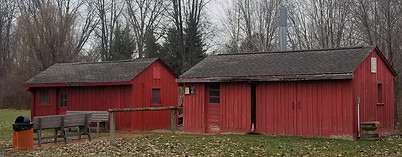Chesterfield
Historical Society
Trinity Buildings

In 1955, Bernard and Ceola Trinity opened a neighborhood library in a small outbuilding on their property near the intersection of Cotton and Sugarbush Roads. Began as a hobby, the Bernard T. Trinity Neighborhood Library grew from 500 books to over 7,500 books and operated for over 36 years. In 1964, The Trinitys expanded the building to include a museum of local artifacts and memorabilia. This museum, The Trinity Historical Museum became a major tourist attraction in Macomb County, visited by 12,000 people each year. It was designed as a general store and its intent was to represent the general stores in Chesterfield Township during the period 1880 – 1930. The Trinitys continued to expand their historical collection and in 1967 began to build a historic village to depict life in the 1890s. The village, named “Heritage Acres,” included farm animals, a barn, a blacksmith shop and a cobbler shop. The library and museum closed in 1991.
The first addition to Heritage Acres was the barn. It was built in 1967. This barn was based on traditional barn designs of the era. Much of the construction was completed by James Harvey. Over the years, it housed many animals which delighted visitors to the museum.
The next addition was the cobbler and harness shop. This was built in 1969 by Bernard Trinity, Karl Karch (father of Ceola Trinity), and Philip Trinity (son of Bernard and Ceola). The shop was designed to demonstrate the manufacture and role of leather goods in the community, particularly shoes and horse harnesses. The bricks that were used for the floor of the cobbler/harness shop were salvaged from the Chesterfield Green School which was built in 1920 and demolished around 1968. The salvaged bricks were hand cleaned by Philip Trinity.
The last addition to Heritage Acres was the blacksmith shop. This building was also constructed by Karl Karch, Bernard and Philip Trinity in 1970. The blacksmith played a vital role in any community, large or small. This is because the blacksmith supplied and repaired most iron products including plows, horse shoes, wagon parts, etc.
The Trinity carriage shed and blacksmith shop were moved to the historic village in July 2006.

The blacksmiths use the forge during historical society events

Today the cobbler building is the historical society's gift shop

Penny candy is sold, just as it was for many years at the Trinity Historical Museum